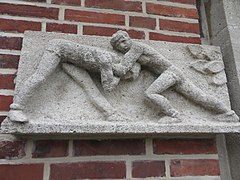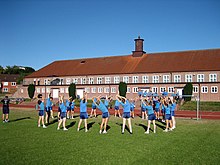Marine Sports School
The Marine Sports School (also: Marine Sports School and Sports School Flensburg-Mürwik ) emerged in the 1920s in the district Flensburg - Mürwik . Its buildings were erected in 1936/37 northeast of the Mürwik Naval School . They are still used today by the Naval School as a sports facility. The school buildings are among the cultural monuments of the district .
history
Beginnings
The marine sports school was apparently established in Mürwik as early as 1924. At that time the older military sports school in Wünsdorf already existed . The activities of the two schools expanded with a view to the first participation of a German team since the First World War in the 1928 Summer Olympics in Amsterdam . These activities intensified with regard to the 1936 Summer Olympics and an air force sports school was established in Berlin-Spandau .
- Reliefs with sports of the time on the building
Construction of the building during the Nazi era and its use as the seat of the last Reich government

The school buildings were built in 1936/37 and have since shaped the beginning of Fördestrasse together with other military buildings. The sports school originally had the address Twedterholz 11. The group of buildings that has been erected includes three long, two-story houses made of red brick that are connected to one another. An imperial eagle still hangs on the building facing Fördestrasse , under whose wings the coat of arms of Flensburg and Schleswig-Holstein can be found. A swastika in a wreath was removed after the end of World War II . There is a gym in the last building away from the street. At the southwest entrance there are reliefs depicting athletes. There is a small clock tower on top of the gym building . Furthermore, sports fields were apparently created. From the end of the 1930s to the beginning of the 1940s there was still a marine sports school in Berlin , at the Olympic site there . It is unclear whether it was a second school, a second location or a temporary replacement for the Mürwik marine sports school. In May 1945, the marine sports school was part of the Mürwik special area . The sports school buildings were the seat of the last Reich government under Karl Dönitz from May 3rd . The unconditional surrender of the Wehrmacht was initiated from here. On the night of May 13th to May 14th 1945, the commander of the Mürwik Naval School, Wolfgang Lüth , was shot dead by a German guard after he apparently failed to give the password issued at a checkpoint. A memorial stone was later placed on the western edge of the sports school. On May 23, 1945, the last government in Mürwik was arrested by British soldiers.
Use as a state sports school after the war
In June 1947 the marine sports school was officially reopened as the municipal sports school in Flensburg-Mürwik, and Siegfried Perrey was given the direction . In 1948 it developed into a state sports school. In 1949 Siegfried Perrey was finally appointed director of the state sports school in Mürwik, which had two tracks for athletes, a hockey field, a box, a fencing and gymnasium. The neighboring marine riding school was also used.
In addition, Hinrich Medau had come to the sports school the year before and founded his Medau school there. In 1929 he founded a gymnastics school in Berlin, in which he conveyed his own teaching approach. In 1943, the Berlin Medau School was bombed out and relocated to Breslau, where it had to close in 1945.
When the fugitive Nazi Werner Heyde , who had played a key role in the euthanasia crimes , learned that the position of a sports doctor at the state sports school was vacant, he applied under the name of Dr. med. Fritz Sawade and was employed in 1949. He bought a row house in Walter-Flex-Weg in the Westliche Höhe district , where a number of Nazis had settled after the war . In 1951, under the direction of Perrey, the German Olympic team was trained for the 1952 Summer Olympics in Helsinki at the state sports school. 1953 Siegfried Perrey was given notice without notice . He was suspected of embezzlement. As a result, he brought an action against the city at the labor court . In 1954, Hinrich Medau and his wife Senta Medau accepted the invitation of the city of Coburg to relocate their Medau school to Hohenfels Castle in Coburg . At the beginning of 1957, the administration of the sports school by the city of Flensburg ended and the German Navy moved into the building and used it from then on for sports training as well as office space.
The military use after the state sports school

Two years later, in 1959, Werner Heyde was exposed. However, before the expected arrest, he left for Frankfurt . There he was finally arrested. Before he could be sentenced, he committed suicide. The part of the street Twedterholz by the marine sports school was renamed Fördestraße in 1961. The marine sports school was given the address Fördestraße 37.
In the eastern part of the gym building there is now the ship simulator for nautical training, which is described as Nautical Ship Command Training Equipment (AANS).
More recently, the city of Flensburg was apparently considering that a museum could be set up in the marine sports school, which was and is part of the naval site. But the plans failed. At the same time, the empty naval hospital in Flensburg-Mürwik continued to fall into disrepair . In May 2015, the historian Gerhard Paul criticized the lack of a museum, stating that where one could remember it is not done, and went on to explain: "Flensburg has struggled with memory to this day." Finally, the city thought about one Museum in the Eckener House in the city center , but the plans were apparently quickly discarded. And people began to think about other alternatives.
various
- Open days are held several times a year , so the sports facilities can be visited every now and then.
- Every year, the participants in the Flensburg Marathon run from downtown Flensburg to the marine sports school, where they complete a lap in the stadium and then return to the city center.
Web links
Individual evidence
- ↑ Sport is a tradition. (PDF) In: Athletics, Emotion, Technology - The Bundeswehr Sports School. P. 14 , accessed on August 11, 2015 .
- ^ Lutz Wilde : City of Flensburg (= monument topography Federal Republic of Germany / cultural monuments in Schleswig-Holstein . Volume 2 ). Wachholtz, Neumünster 2001, ISBN 3-529-02521-6 , pp. 527 .
- ↑ a b c d e f g Lutz Wilde : City of Flensburg (= monument topography Federal Republic of Germany / cultural monuments in Schleswig-Holstein . Volume 2 ). Wachholtz, Neumünster 2001, ISBN 3-529-02521-6 , pp. 526 .
- ↑ a b Eiko Wenzel, Henrik Gram: Zeitzeichen. Architecture in Flensburg . Druckhaus Leupelt, Handewitt 2015, ISBN 978-3-943582-11-6 , pp. 138 .
- ↑ So far, there are unfortunately no really reputable sources on the Internet that clarify this. Research literature on this topic does not appear to be available either; See also: Rudi Gauch and Paul Brock (writer) .
- ↑ a b Broder Schwensen: Mürwik Naval School . In: Society for Flensburg City History (Hrsg.): Flexikon. 725 aha experiences from Flensburg! (= Series of publications by the Society for Flensburg City History ). tape 71 . Flensburg 2009, ISBN 978-3-925856-61-7 .
- ↑ a b Gerhard Paul : The downfall 1945 in Flensburg . Ed .: State Center for Political Education Schleswig-Holstein . Kiel 2012, DNB 1052042201 ( political-bildung-sh.de [PDF; accessed on August 11, 2015] Lecture on January 10, 2012 on the occasion of the opening of the exhibition "What was right at the time ..." in the town hall of Flensburg).
- ↑ a b 70 years after the end of World War II: The last imperial capital Flensburg and a yellowed piece of history. In: Flensburger Tageblatt . May 5, 2015, accessed August 11, 2015 .
- ^ Lutz Wilde : City of Flensburg (= monument topography Federal Republic of Germany / cultural monuments in Schleswig-Holstein . Volume 2 ). Wachholtz, Neumünster 2001, ISBN 3-529-02521-6 , pp. 526 .
- ^ Gerhard Kraack: Flensburg in the past and present . Ed .: Society for Flensburg City History (= series of publications of the Society for Flensburg City History . Volume 22 ). Flensburg 1972, DNB 730485641 , p. 410 .
- ↑ a b c State Sports School . In: Andreas Oeding, Broder Schwensen, Michael Sturm: Flexikon. 725 aha experiences from Flensburg! Flensburg 2009.
- ↑ Press kit, 85 years of Medau School ( memento of the original from December 26, 2017 in the Internet Archive ) Info: The archive link was automatically inserted and not yet checked. Please check the original and archive link according to the instructions and then remove this notice. , Page 2; Retrieved on: December 26, 2017
- ↑ Die Zeit : Gymnastics in our time? , dated: February 8, 1951; Retrieved on: December 26, 2071
- ^ Nazi euthanasia criminal in Flensburg: Werner Heyde: The doctor without a conscience . In: Flensburger Tageblatt , September 1, 2015; accessed on: September 20
- ↑ Press kit, 85 years of Medau School ( memento of the original from December 26, 2017 in the Internet Archive ) Info: The archive link was automatically inserted and not yet checked. Please check the original and archive link according to the instructions and then remove this notice. , Page 2; Retrieved on: December 26, 2017
- ↑ Die Zeit : Gymnastics in our time? , dated: February 8, 1951; Retrieved on: December 26, 2071
- ↑ German Freue Agency: Marine Sports School. In: Hamburger Abendblatt . January 3, 1957, accessed on August 11, 2015 (access to the article only after registration): “After more than ten years of administration, the city of Flensburg […] handed over the […] sports school in Mürwick [sic!] To the German Navy. The school is to be used for the sports training of the ensigns and the accommodation of offices of the naval school [...]. "
- ^ Nazi euthanasia criminal in Flensburg: Werner Heyde: The doctor without a conscience . In: Flensburger Tageblatt , September 1, 2015; accessed on: September 20
- ↑ Dieter Pust: At the saddle place . In: Society for Flensburg City History (Hrsg.): Flensburger street names (= series of publications of the Society for Flensburg City History ). tape 61 . Flensburg 2005, ISBN 3-925856-50-1 .
- ↑ Björn Lenz: Bridge, Bits and Bytes. (No longer available online.) In: Y-Magazin 04/2015. Bundeswehr, April 14, 2015, archived from the original on April 17, 2015 ; accessed on August 11, 2015 . Info: The archive link was inserted automatically and has not yet been checked. Please check the original and archive link according to the instructions and then remove this notice.
- ↑ Holger Ohlsen: Eckenerhaus: CDU initiative for the Flensburg Museum. In: Flensburger Tageblatt. May 15, 2015, accessed August 11, 2015 .
- ↑ Holger Ohlsen: Eckener-Haus: Politics agreed: Flensburg's history needs space. In: Flensburger Tageblatt. May 24, 2015, accessed August 11, 2015 .
Coordinates: 54 ° 48 ′ 53 ″ N , 9 ° 27 ′ 56 ″ E








